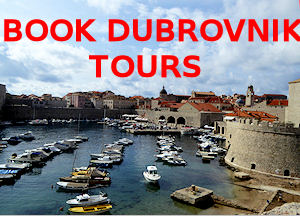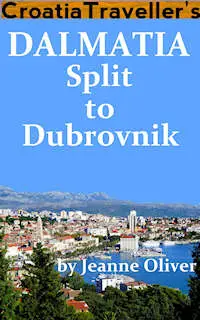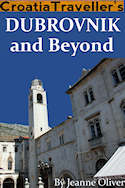The Synagogue
Dubrovnik's tiny synagogue on Zudioska 5 is the oldest functioning Sephardic synagogue and the 2nd oldest synagogue in Europe. It is a site of immense cultural, historical and architectural interest that testifies to the resilience of the Jewish community in Dubrovnik since its inception roughly seven centuries ago.
Highlights include medieval Torah scrolls from Italy, Spain and France, embroidered and lace parochets, 17th-century silver religious objects and a stunning 13th-century Moorish carpet allegedly given by Queen Isabella to her physician before he was expelled from Spain. It's a fascinating visit no matter one's religious affiliation.
Enter the narrow doorway and climb a flight of stairs to the entrance where a caretaker sells tickets (€4.60) and answers any questions you might have. Through the door is a museum that displays artifacts of the Jewish experience in Dubrovnik from the list of victims of the 1667 earthquake to Jewish persecution during WWII. Among the documents is one granting permission to Amatus Lusitanus allowing the Portuguese physician to practice medicine in Dubrovnik in 1557. Another is the decree of French Marshal Marmont granting full emancipation to Dubrovnik Jews in 1808.
One floor up from the museum is the main sanctuary, vaulted with three arches. This tiny jewel evokes a timeless holiness with stately 19th-century Florentine chandeliers, heavy maroon drapes and a delightful sky-blue painted ceiling. The small area is bisected into a front and rear area and was decorated in Italian Baroque style between 1652 and 1670. As the building was damaged in the 1667 earthquake, most of the work undoubtedly came after.
[see more on Dubrovnik history]
Under the central arch is the bimah and on the eastern wall is the aron kodesh flanked by elegant wooden pillars in true baroque style. The Ark holds several priceless Torah scrolls, one of which may have originated in Spain before the 1492 expulsions. The chains dangling from the ceiling holding lamps and oil cups in front of the aron kodesh are emblematic of Sephardic style.
Until the 19th century, women watched the ceremony from screened chambers accessed from the surrounding houses. One can still see the wooden slats on the southern and northern side. Women now sit in the balcony on the western side but during WWII this secret access to the sanctuary allowed members of the community to spirit away the synagogue's treasures for safekeeping.
[Explore Dubrovnik's Jewish heritage with a private guide]
The treasures and the building escaped damage in WWII but were not so fortunate in the bombing of Dubrovnik in 1991. Artillery shells tore through neigbouring buildings shattering windows in the sanctuary. When a shell blasted the ceiling, the community decided it was time to act. All treasures were packed up and sent to Yeshiva University in the US. Getting them back was not so easy. The leader of Dubrovnik's Jewish community who authorized the transfer, Michael Papo, feared that the objects would not be properly cared for in postwar Dubrovnik, particularly given the ever-diminishing size of the Jewish community. He refused to return them and the Jewish congregation in Dubrovnik, backed by the Croatian government, sued. Finally, in 1998, a judge ruled that the treasures must be returned to Dubrovnik, perhaps influenced by the renovation and re-consecration of the synagogue carried out in 1997.
[see more on the bombing of Dubrovnik]
The visitor may be struck by the small size of the synagogue. Even at the height of the Jewish presence in Dubrovnik in the 19th century, the congregation never exceeded 260 people. Before WWII, the congregation was 87; now it is 45, nearly half of whom are no longer resident in Dubrovnik. For high holy days, a rabbi travels from Zagreb for services.
Opening Hours
The museum and synagogue is open daily from May to October 10am to 7pm. From November to April it's open Monday to Friday 10am-3pm. Admission is €6.60
History of Jews in Dubrovnik
Jews probably began arriving in Dubrovnik at the end of the 13th century right about the time when Dubrovnik was extending its trading empire through agreements with Italian and Dalmatian coastal cities to the west and to the east striking up accords with Syria, Epirus and Albania. Still dominated by Venice, it's reasonable to suppose the first Jewish families trickled in from La Serenissima.
The first official mention of a Jewish presence dates from 1356, when the physician Benedict, a Christianized Jew, is mentioned. In 1358 Dubrovnik officially severed its connection with Venice and exploited her position at the crossroads between the West and the mineral-rich lands of Bosnia and Serbia to begin a march toward prosperity. As the land of opportunity, Jewish merchants and physicians began gravitating to the city but were not yet considered residents. The first references to "Giudecca" appeared in documents, referring to an area outside of the city walls reserved for the Jewish population. It was probably not coincidental that it was the same name used by Venice to designate her Jewish neighbourhood.
In the 15th century the Ottomans established a powerful naval presence in the Mediterranean, which meant new commercial opportunities for Dubrovnik. Jewish merchants with their historical links to the Ottoman empire were particularly useful. Yet they were not fully accepted, even after converting, and were not awarded the status of residents within the city.
Related Pages
|
The expulsion of Jews from Spain in 1492 brought a stream of Jews to Dubrovnik either to settle permanently or as a way station on the road to Constantinople. The attitude of the local citizenry was initially hostile. Religious unity was important to Dubrovnik; relations between Dubrovnik and Spain were good; the Jews may have represented undesirable commercial competition. In 1502 a physician and six other Jews were charged with the ritual murder of an old woman. Some died under torture, some were burnt at the stake and the imagined leader was strangled in his prison cell. In 1515 all Jews were expelled from Dubrovnik.
The expulsion didn't last long. In the 1530s, Dubrovnik established close trade relations with the Ottomans and Jews, with their Ottoman links, became integral to the commercial functioning of the city. Raw materials such as leather and spices were imported from the East to be sent West while textiles, paper and other manufactured products were sent from the West to the East. Jewish physicians were much in demand for their skills, including the surgeon Abraham, Doctor Samuel Abeatar and Amatus Lusitanus. Jewish poets and writers enhanced the cultural life of the city and Dubrovnik appointed Jews as Dubrovnik consuls in Albania and Algeria.
The fascinating 16th-century businesswoman Dona Gracia Mendez (Christianized as Beatrice de Luna) also ran a good part of her trade empire out of Dubrovnik. This Portuguese Jew was born wealthy and then became an even wealthier widow. She moved among various European capitals before landing in Dubrovnik and striking up highly lucrative partnerships with Dubrovnik merchants. Even after moving to Constantinople, she maintained special privileges with Dubrovnik that allowed her ships to harbour en route between East and West.
As the Jewish population rose, the problem of residency prompted local officials to establish a ghetto. In 1546 Lojarska street (now Zudioska) was allocated to the Jews. Consisting initially of only four houses and six warehouses, the gates to the street were closed each night. The houses were connected to each other and also with the synagogue by interior passageways, so it was possible to move through the ghetto from house to house, without setting foot outdoors. By 1591 the ghetto was expanded from four to 18 houses but it was still not enough to accommodate the growing population. Many Jews lived outside the city in the Ploce neighborhood.
As Jews were not allowed to drink from the Onofrio fountains, in the 16th-century Dubrovnik Jews got their own fountain within the city walls. When Dubrovnik fell to the French in 1806, restrictions such as these ended and the fountain was moved from its original position under the Bell Tower to a spot just outside Pile Gate where it remains today.
Life in the ghetto was not peaceful. At this time Jewish residents originated partly from Italy and partly from the Ottoman cities and handled trade between the two regions. Competition was fierce and fighting was frequent. Cards and gambling were popular recreational activities which prompted occasionally violent brawls. In addition, differences in religious practices among the various Jewish communities gave rise to disputes.
Attacks by Christians against Jews also occurred and were usually resolved in court. Jews who had converted to Christianity seemed to arouse special ire as recorded in Dubrovnik judicial archives.
The 17th century began well. In 1614 Dubrovnik officials issued a five-year letter of safe conduct to induce more Jewish merchants to settle in Dubrovnik, guaranteeing freedom from arrest and impoundment of their wares. The era of good feeling was not to last. In 1622, a Jewish merchant, Isaac Yeshurun, was accused of the murder of a child. Although he staunchly maintained his innocence, he was sentenced to 32 months imprisonment and heavy restrictions were placed upon the Jewish community, mainly as a result of pressure from the Catholic church. Almost the entire Jewish community left Dubrovnik. As Dubrovnik was essentially a Turkish protectorate at that point, many restrictions went unenforced and a few years later Jews began returning.
In 1652, Jews bought some land east of the city walls to build a cemetery. The Jewish population increased throughout the 18th century. With Jewish schools, marriages and a Jewish bookshop, the 218 Jews were well assimilated into civic life. As far as the economic life, Jews owned, financed and insured many of Dubrovnik's ships.
The problem was that Dubrovnik's golden age was past. As economic decline set in, Jews and other "foreigners" were faced with heavy restrictions, even including confinement within the ghetto. When Dubrovnik fell under French rule in 1808 all restrictions against Jews were abolished. When Dubrovnik passed to Austria in 1815, Jews became subject to the more restrictive laws of Austria. Their population seeped away, never to return.
The Jews remaining in Dubrovnik when the Mussolini's fascists took over the city in 1941 were immediately vulnerable to a wave of anti-Semitic legislation involving restrictions on movement and wearing the yellow star. A concentration camp was set up in Gruz harbour and on the island of Lopud all Jews were interned whether local or from other regions of Croatia. As the government in Zagreb had enthusiastically allied itself with Hitler, many Jews fled south where Italian rule was less lethal.
The Italians did not allow mass deportations but in 1943 about 1700 Jews under their control, including those in the Dubrovnik region, were moved to a concentration camp on Rab Island. A great number of former Jewish inmates of the Rab camp, who regained their freedom, joined the Marshal Tito's Liberation Army. Of 87 Dubrovnik Jews, 24 joined the Liberation Army of whom six were killed in battle. The names of the 27 Jewish victims of the Holocaust are inscribed on a plaque in the Synagogue museum.
Jewish Cemetery
The old Jewish cemetery in Ploce was sold at the end of the 19th century and the graves were moved to the Boninovo cemetery west of town. Now closed temporarily for renovation, the Boninovo cemetery has about 200 tombstones, including 30 from the old cemetery. Some of the horizontal slabs are in traditional Sephardic style with ornamental carving and a Hebrew inscription while others exhibit a Turkish influence, depicting the sun, moon or stars. There are also upright upright tombstones Ashkenazy-style and tombstones. Not all old Jewish tombstones are in the cemetery! Some were used in reconstructing Dubrovnik's northern wall, perhaps after the earthquake of 1667.
Related PagesFurther ResourcesOr get it now on
Dubrovnik and Beyond
|
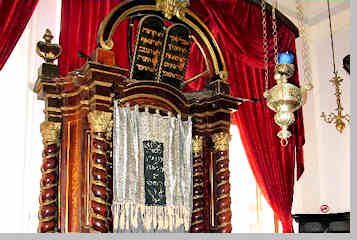
Jewish Fountain
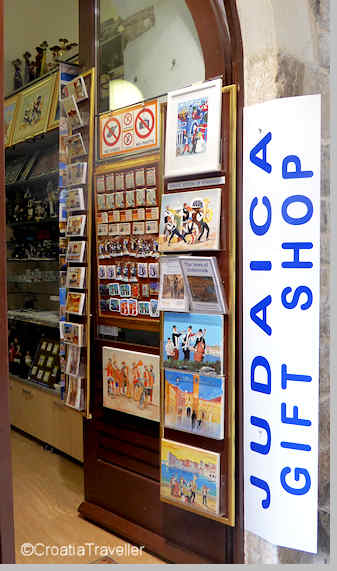
Gift shop next to the Synagogue
Join the Croatia Traveller Group
Recommended Experiences
©CroatiaTraveller 2005-2024 All rights reserved

